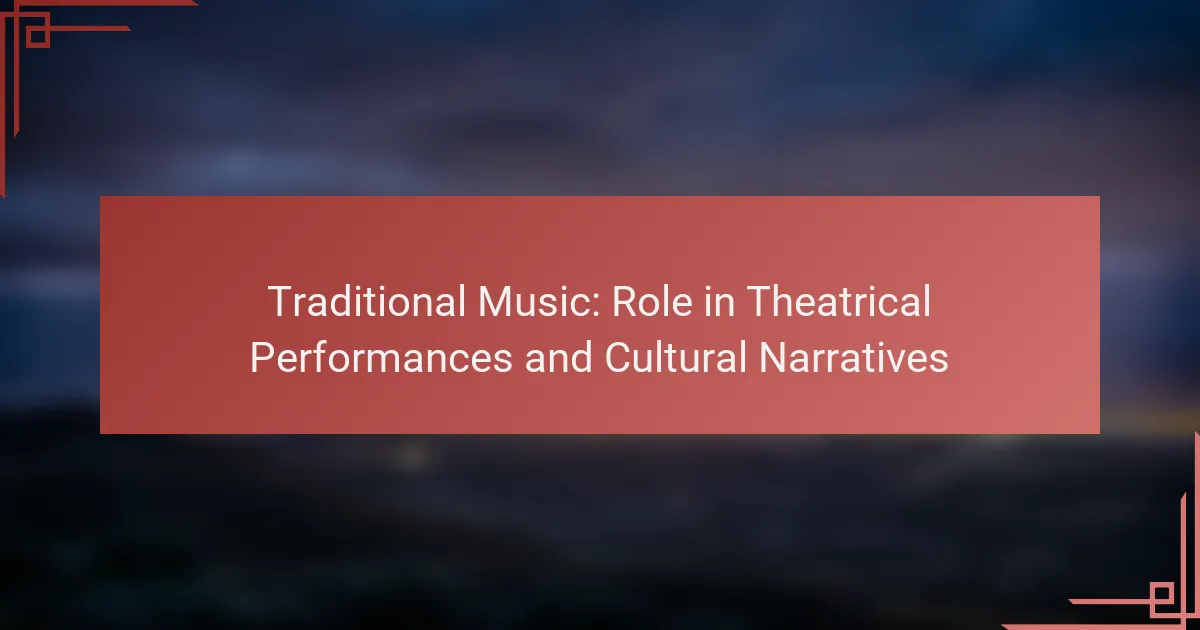Indigenous dance forms are essential expressions of cultural heritage, embodying the history and traditions of various communities through movement and rhythm. As these dances evolve, modern interpretations blend traditional elements with contemporary influences, making them relevant and accessible to today’s audiences. Their global impact fosters cultural exchange and appreciation, enriching the arts landscape while preserving unique narratives and identities.
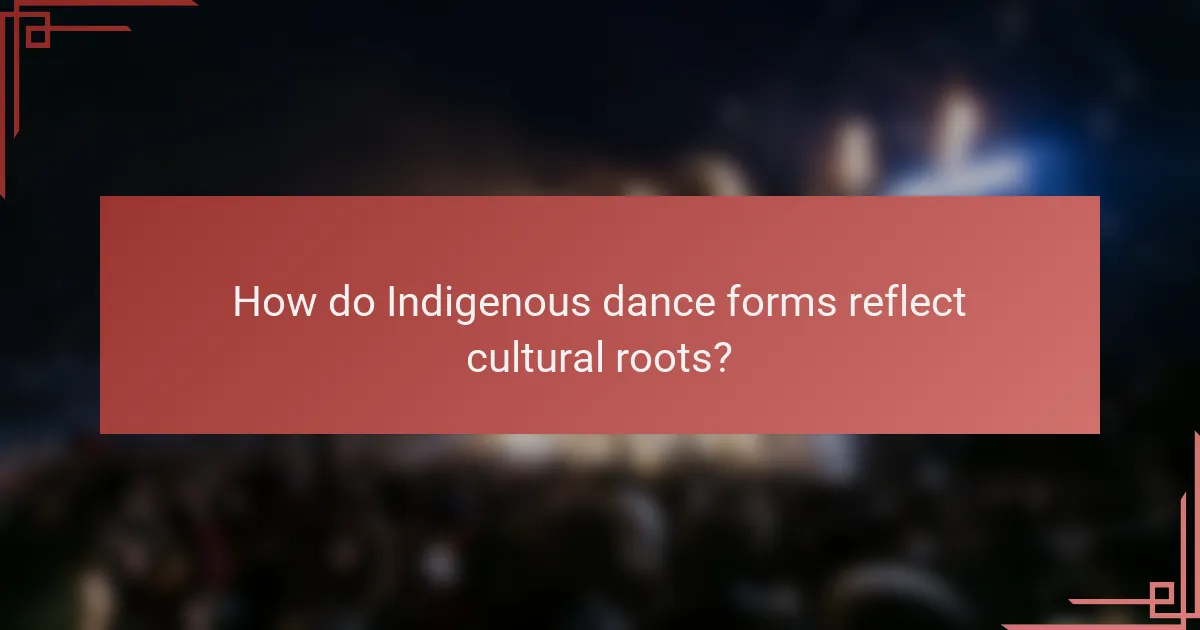
How do Indigenous dance forms reflect cultural roots?
Indigenous dance forms serve as a vital expression of cultural roots, encapsulating the history, beliefs, and traditions of various communities. These dances are not merely performances; they are living embodiments of identity, connecting past and present through movement and rhythm.
Connection to heritage
Indigenous dance forms are deeply intertwined with the heritage of a community, often passed down through generations. Each dance carries specific meanings and stories that reflect the unique experiences and values of the people. For instance, many Native American tribes have dances that commemorate historical events or honor ancestors, reinforcing a sense of belonging and continuity.
In Australia, Aboriginal dance is a crucial aspect of cultural expression, often linked to the Dreamtime stories that explain the creation of the land and its inhabitants. These dances not only preserve history but also educate younger generations about their cultural legacy.
Symbolism in movements
The movements in Indigenous dances are rich with symbolism, often representing elements of nature, spiritual beliefs, or social values. For example, in Hawaiian hula, gestures mimic the natural world, conveying stories about the ocean, land, and ancestors. Each movement is intentional, designed to evoke specific emotions and convey messages.
Similarly, in African dance forms, movements may symbolize life stages, communal values, or spiritual connections. The use of rhythm and body language in these dances serves to communicate complex ideas that words alone may not fully express.
Role in community identity
Indigenous dance forms play a crucial role in shaping and reinforcing community identity. They provide a platform for collective expression, allowing individuals to come together and celebrate their shared heritage. This communal aspect fosters unity and strengthens social bonds among members.
In many cultures, participation in dance is seen as a rite of passage, marking significant life events such as births, marriages, and funerals. These dances create a sense of belonging and help individuals understand their place within the larger community framework.
Traditional storytelling
Indigenous dances often serve as a medium for traditional storytelling, conveying narratives that are central to a community’s cultural identity. Through choreography, dancers narrate tales of creation, heroism, and moral lessons, making the stories accessible to all ages.
For example, the powwow dances of Native American tribes often include elements of storytelling, where each movement and song reflects a part of the narrative. This method of storytelling not only entertains but also educates participants and audiences about their cultural history and values.
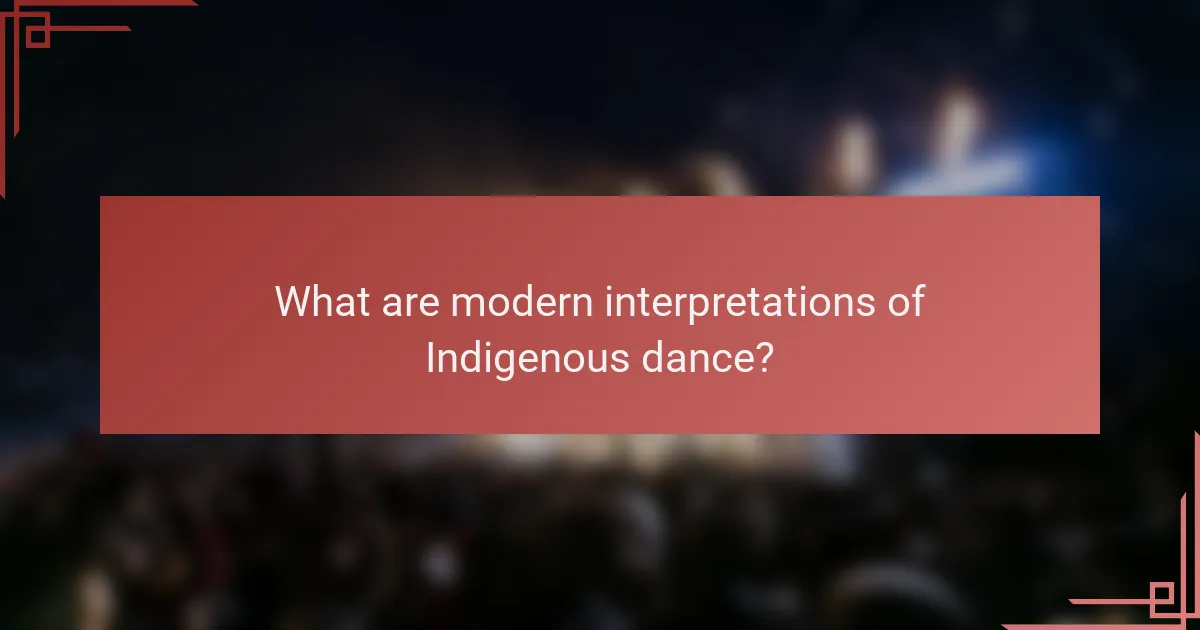
What are modern interpretations of Indigenous dance?
Modern interpretations of Indigenous dance blend traditional elements with contemporary influences, creating dynamic forms that resonate with current audiences. These adaptations often reflect cultural narratives while embracing new styles and technologies, making Indigenous dance more accessible and relevant today.
Fusion with contemporary styles
Many Indigenous dance forms now incorporate contemporary styles such as hip-hop, jazz, and ballet. This fusion allows dancers to express their cultural heritage while appealing to broader audiences. For example, Indigenous choreographers may integrate traditional movements with modern music and staging techniques, enhancing the visual and emotional impact of their performances.
Collaborations between Indigenous artists and contemporary dancers often lead to innovative works that challenge stereotypes and showcase the richness of Indigenous cultures. These partnerships can also foster greater understanding and appreciation among diverse audiences.
Influence of global dance trends
Global dance trends significantly shape modern interpretations of Indigenous dance, as artists draw inspiration from various cultures and styles. This cross-pollination can lead to unique performances that highlight both Indigenous and global narratives. For instance, the use of multimedia elements and social media platforms has expanded the reach of Indigenous dance, allowing it to engage with international audiences.
However, it is essential for artists to maintain the integrity of their cultural roots while exploring these global influences. Balancing innovation with tradition ensures that the essence of Indigenous dance is preserved even as it evolves.
Preservation efforts through innovation
Innovative approaches are crucial for the preservation of Indigenous dance forms in a rapidly changing world. Many communities are using technology, such as video documentation and online platforms, to archive traditional dances and share them with younger generations. This not only helps in preserving the dances but also educates a wider audience about their significance.
Workshops and educational programs that teach both traditional and modern techniques are also vital. By encouraging young dancers to explore their heritage while embracing new styles, these initiatives help ensure that Indigenous dance continues to thrive and evolve in contemporary society.
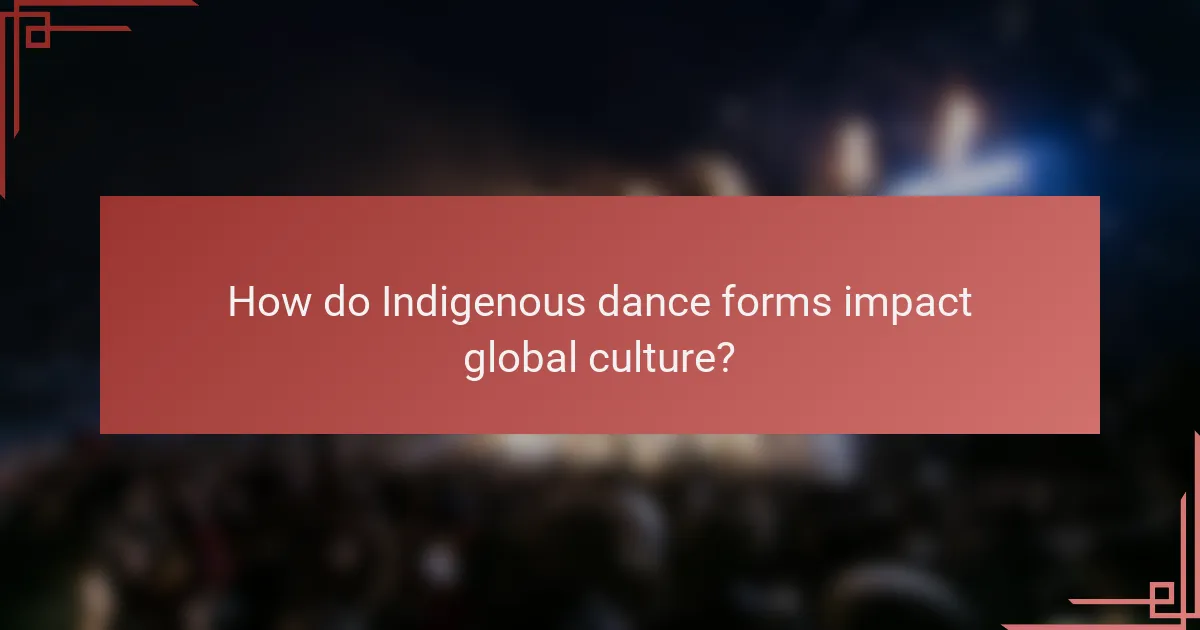
How do Indigenous dance forms impact global culture?
Indigenous dance forms significantly influence global culture by promoting cultural exchange and fostering appreciation for diverse traditions. These dances serve as a medium for storytelling and community identity, enriching the global arts landscape.
Cross-cultural collaborations
Cross-cultural collaborations between Indigenous dancers and artists from other backgrounds create unique performances that blend various traditions. These partnerships often lead to innovative choreographies that highlight the beauty of diversity while respecting cultural roots. For example, Indigenous dance groups may collaborate with contemporary dance companies to create works that resonate with broader audiences.
Such collaborations can also facilitate knowledge sharing, where Indigenous artists educate their partners about the significance of their movements and rituals. This exchange fosters mutual respect and understanding, enriching the artistic community as a whole.
Representation in international festivals
Indigenous dance forms are increasingly featured in international festivals, showcasing their cultural richness to global audiences. Events like the Edinburgh Festival Fringe and the World Arts Festival often include Indigenous performances, allowing artists to share their heritage and stories on a larger stage.
These festivals not only provide visibility but also create opportunities for Indigenous artists to network with other performers and cultural organizations. This exposure can lead to further collaborations and increased awareness of Indigenous issues in the arts.
Educational initiatives promoting awareness
Educational initiatives that focus on Indigenous dance forms play a crucial role in promoting cultural awareness and appreciation. Workshops, seminars, and school programs often introduce students to the history and significance of these dances, fostering a deeper understanding of Indigenous cultures.
Additionally, online platforms and documentaries can reach wider audiences, providing insights into the techniques and meanings behind various Indigenous dance forms. Engaging with these resources can help dispel stereotypes and encourage respect for Indigenous traditions in a global context.
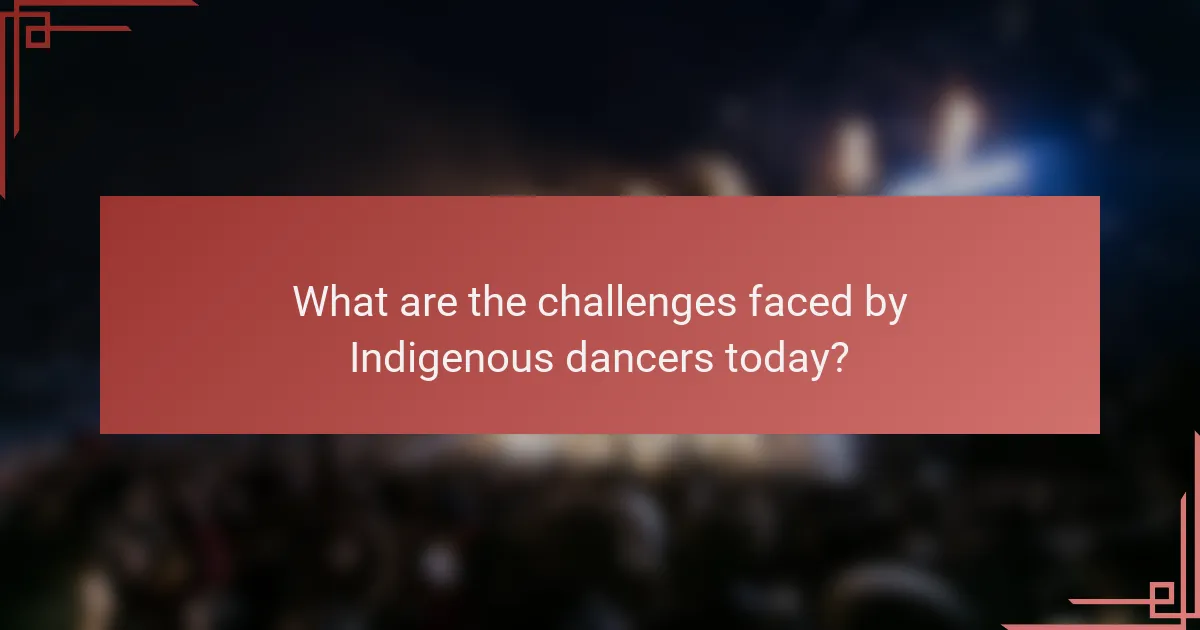
What are the challenges faced by Indigenous dancers today?
Indigenous dancers today encounter several significant challenges that impact their ability to preserve and perform their cultural practices. These include commercialization, loss of traditional knowledge, and limited access to funding and resources.
Commercialization of cultural practices
The commercialization of Indigenous dance can dilute its cultural significance, transforming sacred rituals into mere entertainment. This shift often prioritizes profit over authenticity, leading to performances that may misrepresent or oversimplify traditional elements.
Many Indigenous dancers struggle with the pressure to adapt their art for mainstream audiences, which can compromise the integrity of their cultural expressions. To navigate this, dancers must balance artistic expression with the preservation of their heritage, often requiring careful negotiation with promoters and venues.
Loss of traditional knowledge
As generations pass, the transmission of traditional dance knowledge faces significant risks, particularly due to urbanization and globalization. Younger dancers may not have the same access to elders who hold the wisdom of their cultural practices, leading to gaps in understanding and performance.
Efforts to document and teach traditional dances are crucial for maintaining cultural continuity. Workshops, community gatherings, and mentorship programs can help bridge these gaps, ensuring that younger generations learn the significance and techniques of their heritage.
Access to funding and resources
Securing funding for Indigenous dance projects can be a major hurdle, as many grants and sponsorships favor mainstream art forms. This lack of financial support limits opportunities for performances, workshops, and cultural exchanges that are vital for sustaining Indigenous dance.
To improve access to funding, dancers and organizations can collaborate with cultural institutions and seek partnerships that align with their values. Additionally, applying for grants specifically aimed at supporting Indigenous arts can provide essential resources for projects that promote cultural heritage.
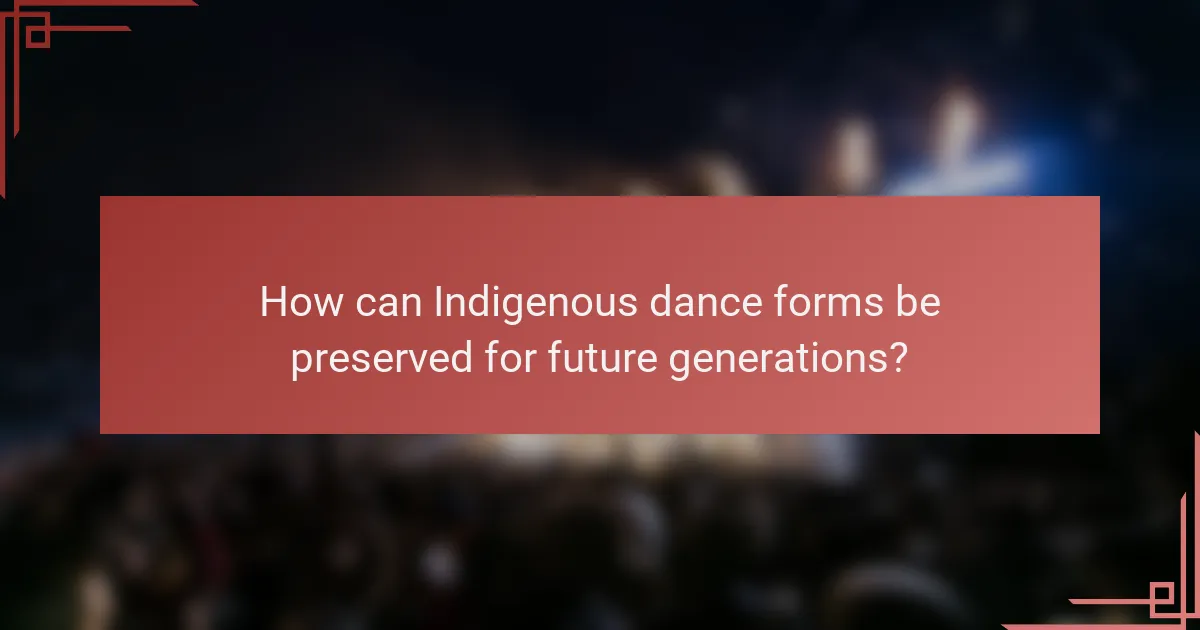
How can Indigenous dance forms be preserved for future generations?
Indigenous dance forms can be preserved through community engagement, digital documentation, and educational partnerships. These strategies ensure that traditional practices are maintained while adapting to contemporary contexts.
Community-led workshops
Community-led workshops are essential for passing down Indigenous dance forms. These workshops allow elders and experienced dancers to teach younger generations the techniques, stories, and cultural significance behind each dance. Regular sessions can foster a sense of belonging and continuity within the community.
To maximize participation, workshops should be accessible and inclusive, offering sessions at various times and locations. Collaborating with local organizations can help promote these events and attract diverse participants.
Digital archiving of performances
Digital archiving of performances is a powerful tool for preserving Indigenous dance. By recording and cataloging performances, communities can create a visual library that showcases their cultural heritage. This archive can be used for educational purposes and to reach wider audiences.
When creating digital archives, consider using high-quality video and audio equipment to capture the nuances of each performance. Additionally, including contextual information, such as the history and meaning of the dances, enhances the educational value of the archives.
Collaboration with educational institutions
Collaboration with educational institutions can significantly enhance the preservation of Indigenous dance forms. Schools and universities can integrate Indigenous dance into their curricula, providing students with opportunities to learn and appreciate these cultural expressions. Such partnerships can also facilitate research and documentation efforts.
To establish effective collaborations, reach out to local schools and universities with proposals that highlight the benefits of including Indigenous dance in their programs. Workshops, guest lectures, and performance opportunities can enrich the educational experience for students while honoring Indigenous traditions.
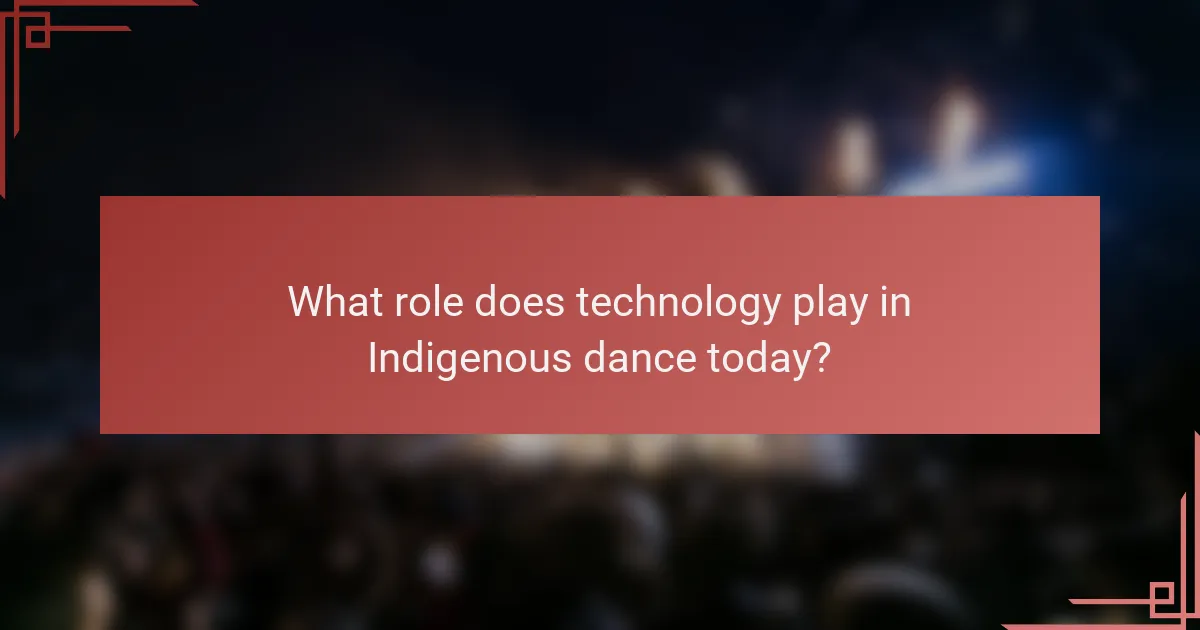
What role does technology play in Indigenous dance today?
Technology plays a significant role in Indigenous dance by enhancing visibility, facilitating collaboration, and preserving cultural heritage. Through various digital platforms, Indigenous dancers can share their art with a global audience, ensuring their traditions are recognized and celebrated.
Use of social media for promotion
Social media has become a vital tool for Indigenous dancers to promote their performances and cultural narratives. Platforms like Instagram, Facebook, and TikTok allow artists to showcase their dance forms, engage with audiences, and build communities around their cultural practices.
By utilizing hashtags and engaging content, dancers can reach wider audiences and connect with individuals interested in Indigenous cultures. This visibility can lead to increased attendance at events and greater support for Indigenous art initiatives.
However, it is essential for dancers to maintain authenticity and respect cultural protocols when sharing their work online. Balancing promotion with cultural integrity is crucial to ensure that the essence of Indigenous dance is preserved while engaging with modern technology.


